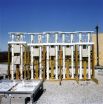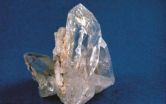(Press-News.org) A promising new approach for checking the accuracy of measurements of hazardous indoor air pollutants may soon be ready for prime time, report researchers from the National Institute of Standards and Technology (NIST) and Virginia Tech.* The measurement tool, a reference sample for volatile organic compounds (VOCs), would be a boon to testers of indoor air quality and to manufacturers of paints, rugs, cleaners and other building products.
The researchers put their innovation—thin squares of plastic saturated with vapors of a common solvent—through the paces at four testing laboratories. The prototype test material, made at Virginia Tech, yielded measurement results more accurate than those previously achieved in more costly and time-consuming interlaboratory studies using less standardized materials.
The researchers suggest that their method might be used to produce a range of reference materials to validate measurements of VOCs emitted from building materials and products. VOCs are used in paints, adhesives, furniture and many other indoor products. Indoor levels of some VOCs average two to five times higher than outdoors, according to the Environmental Protection Agency.
VOC emissions from building materials and products have been linked to occupant illness, reduced worker productivity, and increased requirements for ventilation/air cleaning, leading to increased energy consumption. As a result, low VOC emitting products are being used more widely in buildings to help achieve a healthy and sustainable indoor environment.
Several programs for testing VOC emissions from building products exist, and manufacturers often test their products to determine that emissions are below limits set in regulations or voluntary standards. However, results often vary significantly.
Past evaluations of test performance have been based on how much measurements reported by individual laboratories differ from the average value for the entire set of laboratories. "These kinds of inter-laboratory comparisons can take months to conduct," explains NIST environmental engineer Cynthia Howard-Reed, lead author of the new report, "and, unfortunately, the results are relative because there is no true reference value for determining just how accurate an emission measurement really is."
That's the gap the researchers are trying to fill. They aim to produce VOC reference materials—standardized test samples that produce known results when analyzed. These benchmark references are commonly used in industry to check the accuracy of important measurement instruments.
In the initial trial, they prepared two batches of their sample material—thin films of polymethyl pentane, a plastic used in gas-permeable packaging, saturated with toluene, a common VOC found in paint and other products. A mathematical model developed by the research team is used to accurately predict rates of emission from the sample over time. The preliminary multi-laboratory tests showed that the prototype reference material is uniform in composition and sufficiently stable and that rates of VOC emissions within and between production batches are consistent.
The researchers conclude that their prototype could reduce inter-laboratory variability in results to less than 10 percent—much better than current methods.
The pilot study also identified several opportunities for improvement, which will be incorporated before an international pilot is conducted later this year. With further progress, the project will be expanded by 2013 to include more types of VOC references that will be produced in larger batches for broader distribution.
INFORMATION:
* C. Howard-Reed , Z. Liu, J. Benning , S. Cox, D. Samarov, D. Leber, A.T. Hodgson, S. Mason, D. Won and J.C. Little. Diffusion-controlled reference material for volatile organic compound emissions testing: Pilot inter-laboratory study. Building and Environment 46 (2011) 1504-1511.
New tool debuts for measuring indoor air pollutants
2011-03-18
ELSE PRESS RELEASES FROM THIS DATE:
New NIST testing device may help to 'seal the deal' for building owners
2011-03-18
Just as a chain is as strong as its weakest link, a building is as secure against the environment as its most degraded joint sealants, about 50 percent of which fail in less than 10 years after installation.
The upshot for U.S. homeowners is that moisture damage due to failed sealants is responsible for much of the $65 billion to $80 billion they collectively shell out for house repairs annually.
Researchers at the National Institute of Standards and Technology (NIST) are assembling a toolkit of measurement devices and scientific data that will help manufacturers of ...
Study shows attendance at state parks grows, even as funding decreases
2011-03-18
A recent study from North Carolina State University shows that while the number of visits to state parks across the country has grown, fund support for park operations has been significantly reduced. The reduction in funding during a time of park growth endangers the more than $20 billion in economic impact that state parks have on the nation's economy.
"Obviously the reduction in general-fund support for operations puts stress on America's state-park systems," says Dr. Yu-Fai Leung, NC State associate professor of recreation ecology, park planning and visitor management, ...
3 in 4 domestic violence victims go unidentified in emergency rooms, Penn study shows
2011-03-18
PHILADELPHIA -- More than three quarters of domestic violence victims who report the incidents to police seek health care in emergency rooms, but most of them are never identified as being victims of abuse during their hospital visit. These findings, from a new University of Pennsylvania School of Medicine study, point to a missed opportunity to intervene and offer help to women who suffer violence at the hands of an intimate partner.
"Emergency departments are a safety net for women with health issues of all kinds, but our study shows we're not doing a good enough job ...
New findings on the developments of the earthquake disaster
2011-03-18
16.03.2011 | Potsdam: The earthquake disaster on 11 March 2011 was an event of the century not only for Japan. With a magnitude of Mw = 8.9, it was one of the strongest earthquakes ever recorded worldwide. Particularly interesting is that here, two days before, a strong foreshock with a magnitude Mw = 7.2 took place almost exactly at the breaking point of the tsunami-earthquake. The geophysicist Joachim Saul from the GFZ German Research Centre for Geosciences (Helmholtz Association) created an animation which shows the sequence of quakes since March 9.
The animated image ...
Bargain Deals for Italian and Spanish Restaurants This Month with DiscountVouchers.co.uk
2011-03-18
Eating out in the UK at top restaurant chains just became more affordable to all thanks to the latest deals from consumer voucher codes website DiscountVouchers.co.uk. The country's diners can enjoy money-saving deals this month redeemable at famous restaurants Zizzi, Ask and La Tasca.
Zizzi is one of the country's favourite Italian restaurant chains and this month DiscountVouchers.co.uk can help people enjoy eating out there without having to break the bank. Available at present on the DiscountVouchers.co.uk website is a Zizzi voucher for getting 2 main meals for only ...
Ancient 'hyperthermals' a guide to anticipated climate changes
2011-03-18
Bursts of intense global warming that have lasted tens of thousands of years have taken place more frequently throughout history than previously believe, according to evidence gathered by a team led by Scripps Institution of Oceanography, UC San Diego researchers.
Richard Norris, a professor of geology at Scripps who co-authored the report, said that releases of carbon dioxide sequestered in the deep oceans were the most likely trigger of these ancient "hyperthermal" events. Most of the events raised average global temperatures between 2° and 3° Celsius (3.6 and 5.4° ...
Standards education vital for global business needs, says Asia-Pacific Economic Group
2011-03-18
In just a few months, millions of young adults will graduate from college and step into productive careers in the global economy. Meanwhile, those already involved in standardization, particularly in the engineering and technology sectors, and increasingly those with policy, legal, and business backgrounds, are working in a new environment where standards play a crucial role in international trade and competitiveness. But according to the attendees of a meeting of the Asia-Pacific Economic Cooperation (APEC) Subcommittee on Standards and Conformance, comparatively few new ...
The RV Chef is Now Online!
2011-03-18
When you pull off the highway and head into your favorite campground, don't forget to tune in the latest Internet program - The RV Chef.
RV Chef is produced for RVers to show that food on the road does not have to be fast or mediocre. With some planning and preparation, wonderful meals are no further away than the picnic table.
As the producer and chef, George Murphy has gained a lot of experience in the 25 years he's been RVing. "We hope to produce one program every week or so that will run from 5 - 8 minutes and each and will show the viewer how to make wonderful ...
High-tech concrete technology has a famous past
2011-03-18
In the business of concrete making, what's old—even ancient—is new again.
Almost 1,900 years ago, the Romans built what continues to be the world's largest unreinforced solid concrete dome in the world—the Pantheon. The secret, probably unknown to the Emperor Hadrian's engineers at the time, was that the lightweight concrete used to build the dome had set and hardened from the inside out. This internal curing process enhanced the material's strength, durability, resistance to cracking, and other properties so that the Pantheon continues to be used for special events to ...
Viscous cycle: Quartz is key to plate tectonics
2011-03-18
More than 40 years ago, pioneering tectonic geophysicist J. Tuzo Wilson published a paper in the journal Nature describing how ocean basins opened and closed along North America's eastern seaboard.
His observations, dubbed "The Wilson Tectonic Cycle," suggested the process occurred many times during Earth's long history, most recently causing the giant supercontinent Pangaea to split into today's seven continents.
Wilson's ideas were central to the so-called Plate Tectonic Revolution, the foundation of contemporary theories for processes underlying mountain-building ...





